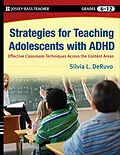ADHD expert offers help for teaching the content areas tostudents with attention problems Written by an expert in the field of ADHD, this importantresource offers strategies to teach adolescents with ADHD acrossall core content areas: English Language Arts, Math, Science, andSocial Studies. These strategies have been classroom-tested andproven to engage students during content instruction so that theywill gain a lasting understanding of the material taught. Asstudents interact with the content--talk, write, draw, andcreate a variety of media in relation to the content--allstudents, including those with ADHD, will learn the basicsnecessary for post-secondary education and employment. * Offers an important guide for teaching core content toadolescents with ADHD * Includes information for engaging ADHD students in a way thatmakes content memorable * Explains how to use the strategies to teach allclassroom students * Written by a nationally known authority on ADHD * Published in partnership with the acclaimed WestEdorganization
Autorentext
Silvia L. DeRuvo, M.A, is a Special Education Resources Development Specialist for WestEd. She teaches Special Education courses at Sacramento State University and speaks nationally on the topics of ADHD, Response-to-Intervention, and inclusion of special needs children in general classrooms. A past president of the California Association of Resource Specialists and Special Educators (CARS+), DeRuvo has twenty years' experience as a special educator working with children with mild to moderate disabilities.
Klappentext
This practical, hands-on guide offers teachers proven strategies that can be easily implemented in the classroom to boost learning for teenagers with ADHD. Written by Silvia L. DeRuvo, an experienced special educator and teacher trainer, Strategies for Teaching Adolescents with ADHD is filled with research-based interventions for teaching the core content areas: English/language arts, math, science, and social studies. These tested methods help students to interact with the content in a variety of media including speaking, writing, drawing, and movement. The strategies provided here are designed to seamlessly blend into core content instruction and can be used across all content areas.
DeRuvo provides insight into the biological and neurological components of ADHD and shows how the disorder manifests in teens academically, socially, and behaviorally. The book identifies the markers of ADHD in both girls and boys, and explains targeted accommodations that can help them achieve success both inside and outside the classroom. While the book offers information that highlights working with ADHD students, the strategies and techniques offered in this book can be used to help all students succeed.
Zusammenfassung
ADHD expert offers help for teaching the content areas to students with attention problems
Written by an expert in the field of ADHD, this important resource offers strategies to teach adolescents with ADHD across all core content areas: English Language Arts, Math, Science, and Social Studies. These strategies have been classroom-tested and proven to engage students during content instruction so that they will gain a lasting understanding of the material taught. As students interact with the contenttalk, write, draw, and create a variety of media in relation to the contentall students, including those with ADHD, will learn the basics necessary for post-secondary education and employment.
- Offers an important guide for teaching core content to adolescents with ADHD
- Includes information for engaging ADHD students in a way that makes content memorable
- Explains how to use the strategies to teach all classroom students
- Written by a nationally known authority on ADHD
- Published in partnership with the acclaimed WestEd organization
Inhalt
About This Book.
The Author.
Acknowledgments.
1 Why Another Book on ADHD?
Education in the Twenty-First Century: The No Child Left Behind Act and Federal Accountability.
The Individuals with Disabilities Education Act of 2004.
Students with ADHD and Special Education: Section 504 of the Rehabilitation Act of 1973.
Teaching in the Twenty-First Century: Current Research and Instructional Practice.
Differentiated Instruction.
The Student-Centered Classroom.
Standards-Aligned Instruction.
To Sum Up.
2 Understanding ADHD in Adolescents.
Willful Disobedience or Neurological Disorder?
Understanding the Nerve Cell.
Types of ADHD.
Primary Symptoms of ADHD.
Defining ADHD.
ADHD in Girls.
The Impact of ADHD on Adolescents.
Hyperactive Students.
Inattentive Students.
Academic Indicators of ADHD.
Why Do Adolescents with ADHD Struggle?
The Role of Executive Functions.
The Effects of Weaknesses in Executive Functions.
Other Disorders Associated with ADHD.
Learning Disabilities.
Anxiety and Mood Disorders.
Oppositional Defiant Disorder and Conduct Disorder.
To Sum Up.
3 Research-Based Teaching Strategies: Meeting the Needs of All Learners.
The Engaging Classroom.
Focus on Student Learning.
Research-Based Strategies That Support Students with ADHD.
Asking Students to Identify Similarities and Differences.
Teaching Students to Summarize and Take Notes.
Reinforcing Effort and Providing Recognition.
Focusing on the Important Aspects of Homework and Practice.
Using Nonlinguistic Representations.
Facilitating Cooperative Learning.
Setting Objectives and Providing Feedback.
Challenging Students to Generate and Test Hypotheses.
Using Cues, Questions, and Advance Organizers.
Meeting the Academic Challenges of Students with ADHD.
Recognizing Different Learning Styles.
Differentiated Instruction: Principles of Universal Design for Learning.
Implementation of Instructional Strategies: Meeting the Needs of All Students Through Standards-Aligned Instruction.
Identifying Standards to Be Addressed.
Planning Instruction to Meet the Standards.
Linking IEP Goals to Standards-Based Instruction.
Connecting the Lesson to the Standard.
Instructional Design That Supports Students with ADHD.
Rituals and Routines.
Instructional Scaffolding.
Checking for Understanding.
Independent Practice.
To Sum Up.
4 Strategies to Support Students with ADHD in English Language Arts.
The Learner-Centered Classroom.
Developing Collaboration Skills.
Taking Ownership of Learning.
Teaching English Language Arts.
The Research.
The Practice.
Explicit Vocabulary Instruction.
Explicit Instruction in Comprehension Strategies.
Motivation and Engagement in Literacy Learning.
Intensive Individualized Interventions.
Writing Instruction.
To Sum Up.
5 Strategies to Support Students with ADHD in Math.
Mathematical Knowledge.
The Research.
The Practice.
Math Problem-Solving Strategies.
Mnemonic Instructional Strategies.
Concrete-Representational-Abstract Instructional Strategy.
Graphic Organizer Strategies.
Putting it All Together: Strategies for Accessing Algebraic Concepts.
Mnemonics Example in Algebra.
Concrete-Representational-Abstract Example in Algebra.
Graphic Organizer Examples in Algebra.
To Sum Up.
6 Strategies to Support Students with ADHD in Science and Social Studies.
The Research: Science.
The Practice: Science.
Motivating Rel…
